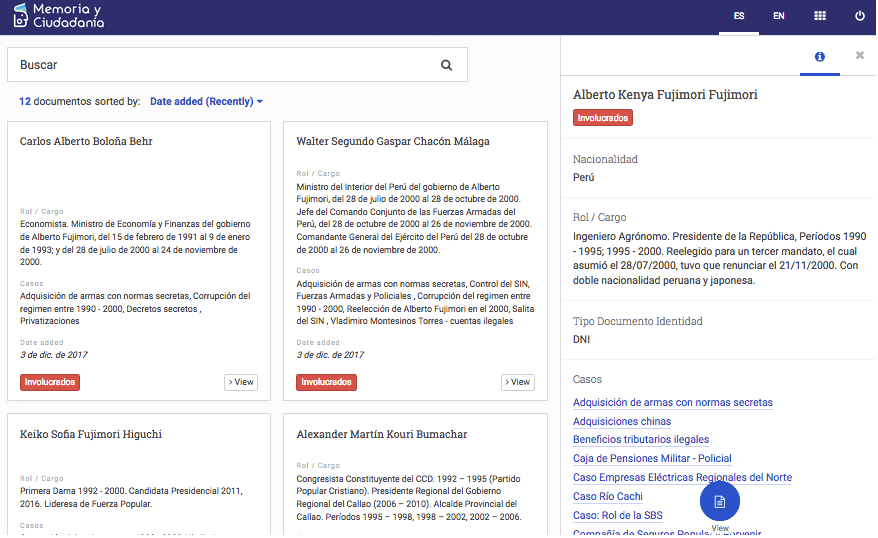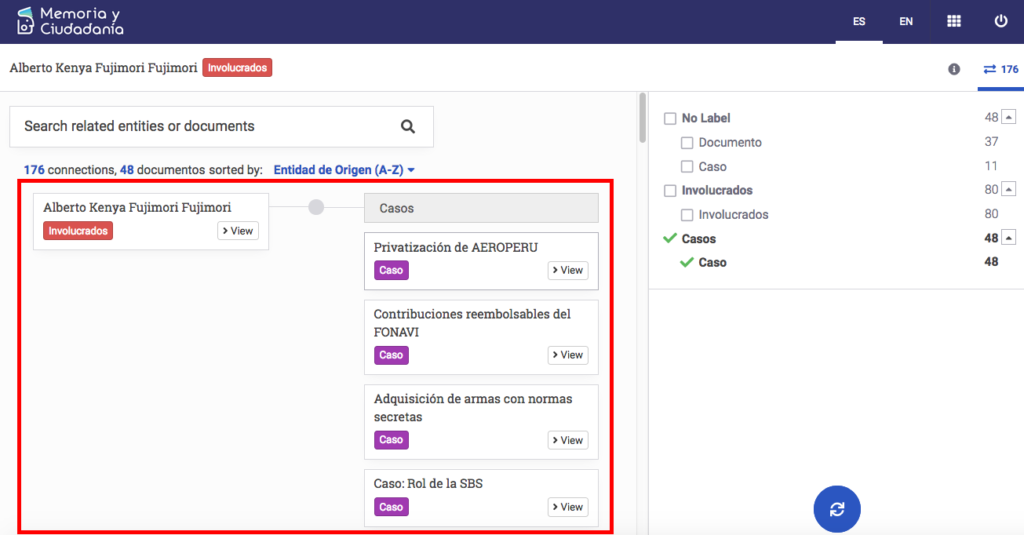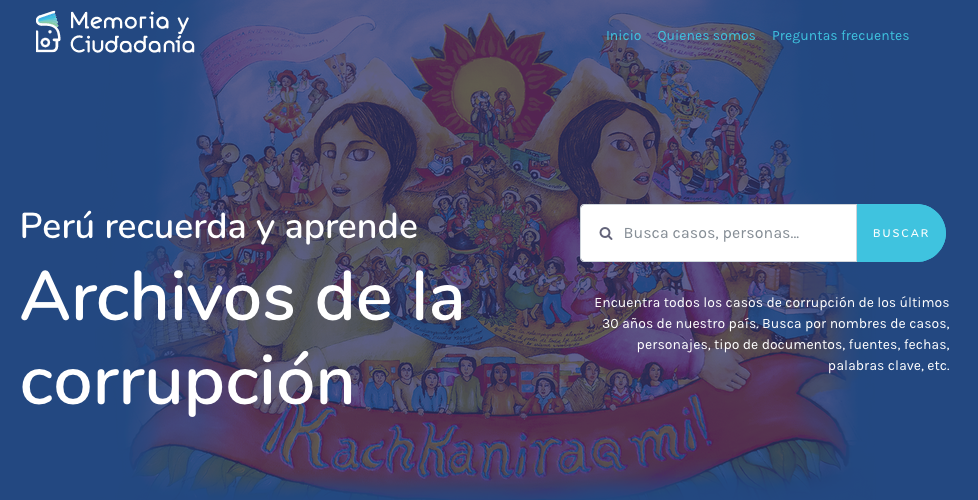Este post está disponible también en español.
At HURIDOCS, our partners drive our technology development. We built Uwazi based on the needs of human rights groups in Africa – to organise and publish human rights documents. But alone, we can’t imagine all the ways that human rights groups will want to use Uwazi – we need organisations to come to us with the problem they want to address and the goals they are trying to achieve.
Japiqay came to us (via The Engine Room) with their goal of telling the story of corruption in Peru, and their problem of finding an effective way to tell this story with the documents and media they had collected. Through our work with Japiqay, we ended up redesigning the way users create relationships between documents (and entities) in Uwazi.
We’re often unable to share concrete examples of how user experience guides our technology development because of the sensitivity of our partners’ work. So we’re thrilled and proud to share what has come out of our work with Japiqay and how it has improved our technology, in this blog post.
About the Memoria y Ciudadanía project
Corruption is a systemic and pervasive problem in Peru. The country ranks an abysmal 89th (out of 113 countries) in World Justice Project’s Rule of Law Index 2017 – 2018. And unfortunately, corruption is intimately connected to the persistence of other human rights issues.
“The first experiences we had were helping social causes such as workers unions against privatisation programs and native communities defending their lands. In all those cases, it was very important to show the crimes committed by corrupt authorities.”
– Lourdes Chávez, Co-Founder of Japiqay
Civil society is fed up with the culture of secrecy and the collective amnesia that are fundamental allies of corruption and impunity. Japiqay is born out of these frustrations and the desire to end corruption in Peru through the preservation of collective memory.
“We need to recover the history and shed light on corrupt relationships to promote transformation, accountability and to modify the structures that make possible for a few people to take control over the State. That’s our job as documentalists and the vision of the country we want.”
– Lourdes Chávez, Co-Founder of Japiqay
In 2016, Japiqay approached The Engine Room’s Matchbox project to ask for their help in building a digital documentation center about corruption in Peru. Knowing we had recently developed an open source platform for publishing documents collections, The Engine Room turned to HURIDOCS for support with the platform. Together, we built Memoria y Ciudadanía.
Memoria y Ciudadanía (Memory and Citizenship, in English) is a collection of official reports, testimonies, court and financial records, transcripts, videos and more that tell the story of corruption in Peru. The more than 1,500 documents constitute the documentary memory of corruption cases that have been investigated by parliamentary commissions over the past years in Peru. The documents were collected by archivist Lourdes Chavez and investigative journalist Gabriela Flores over several years. The project was launched in Lima on 7 December 2017, International Anti-Corruption Day.
The challenge for HURIDOCS: two-hop-connection
To build the Memoria y Ciudadanía digital documentation center, we used Uwazi, our free and open source tool to make human rights information more accessible. With the help of David Losada who documented Japiqay’s data model, we were able to configure Uwazi to meet their immediate needs so that the platform could launch on-time. But there was something we knew we wanted to improve.
David’s thorough description of their data model included a complicated relationship type that we nicknamed the “two-hop-connection”.

Basically, Japiqay wanted to be able to connect “case A” to “person B” via the document to which they are both connected. This was a complex relationship to represent because we needed to figure out how to distinguish multiple cases and multiple people, all related to the same document but not necessarily related to each other. (You can read more about this data relationship challenge and our approach to addressing it in this Uwazi Relationships Cheat Sheet. We know this stuff is complicated, so we tried to make it fun!)
The HURIDOCS solution: information hubs
Our solution was to create information hubs, which are connection points that allow you to put series of documents and entities together while also being able to segregate information when needed. With this hub approach, a user will see in a single view, all the documents connected to a person in addition to any other information connected to this person, such as events, accomplice, victim, or perpetrator.
This change in Uwazi relationships has improved the interaction and visualisation of information for users and has made it easier for organisations to structure the information when uploading it to the platform. Before the information hubs, a user could only have a 1-to-1 type of relationship, where document/entity A is connected to document/entity B. This approach is good for many scenarios, but for more complex relationships, the user would need to eventually duplicate data and/or repeat relationships.
Here is where the hub is helpful: document B is connected to a hub X, and to hub X a user can connect all of the people referenced in the document. With one single process, entities involved are not only connected, but they are connected in a many-to-one way that doesn’t require any duplication (and doesn’t require joining tables!).

In the gif above from the Memoria y Ciudadanía collection, Alberto Fujimori is referenced in more than 20 documents that describe different events, victims and associates. From the relationships view, a visitor can open and read each document, and explore that document’s connections.
But most importantly, from the relationship view a visitor can also see the list of cases that are connected to Alberto Fujimori via documents, which is what Japiqay had originally requested!

Yes, we’re data geeks and we get excited about this kind of thing. But this was much more than an interesting challenge – it turned out to be a significant step towards expanding Uwazi, our flagship database application, to meet the needs of human rights defenders who document violations.
How is the Memoria y Ciudadanía collection being used?
The goal of Memoria y Ciudadanía document collection is to support the advocacy efforts of civil society organisations, provide evidence for legal proceedings, and bolster the investigative work of journalists.
In Peru, like so many other countries struggling with high levels of corruption, it is journalists and civil society organisations that reveal the truth behind the veil within which corrupt institutions, companies and government officers work. Romina Mella, co-founder of IDL Reporteros, explains that often it is because of their work that institutions and courts feel the pressure and responsibility to carry out the necessary investigations, in a consistent and timely manner. This document collection helps them find inconsistencies and areas in which the courts could be doing better.
We, investigative journalists, will have to reveal and expose; and as we move forward, the prosecutor will investigate and go deeper. That’s how it has been, on the García and Keiko Fujimori’s case there has been a clear policy of not being persistent and not investigating deep enough, which is different from other cases such as Ollanta Humala o Alejandro Toledo.
– Romina Mella, co-founder of IDL Reporteros during an interview on #ContraElOlvido, Japiqay and Gran Angular YouTube program.
The Memoria y Ciudadanía document collection has already contributed to helping workers’ unions strengthen their legal cases in their fight against privatisation, and native communities in defending their lands by supporting their claims with evidence of related corruption.
We are proud to provide Japiqay with the Uwazi platform for their Memoria y Ciudadanía project. This partnership has helped us learn more about the needs of human rights organisations who want to use Uwazi to reveal relationships between people, documents, corporations, and cases. We feel honored to work with such a committed team of women working to recover collective memory, claim the right to the truth, and fight impunity in Peru.
We want to thank Lourdes Chávez from Japiqay and Anca Matioc from The Engine Room for their collaboration in this project and this blogpost. You can read more about The Engine Room’s reflections on this partnership on their blog, in English and in Spanish.
